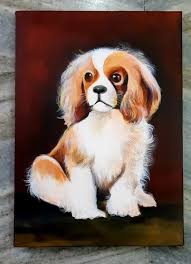The Timeless Appeal of Dog Painting
Throughout history, dogs have held a special place in the hearts of humans. Their loyalty, companionship, and unique personalities have inspired artists for centuries. One art form that particularly captures the essence of these beloved animals is dog painting.
Dog painting is a genre that celebrates the beauty and character of our canine friends. Artists use various styles and techniques to portray dogs in different settings, capturing their playful antics, noble demeanour, or soulful expressions. From realistic portraits to abstract interpretations, dog paintings offer a diverse range of artistic interpretations.
One of the reasons why dog painting remains popular is its ability to evoke emotion and connection with viewers. Whether it’s a lifelike depiction of a beloved pet or a whimsical portrayal of dogs at play, these artworks often strike a chord with animal lovers and art enthusiasts alike.
Many renowned artists throughout history have created masterful dog paintings that continue to captivate audiences today. From the iconic works of George Stubbs to the charming illustrations of Norman Rockwell, each artist brings their unique perspective to this timeless subject.
For dog owners, having a custom portrait of their furry companion can be a cherished memento that immortalises their pet’s spirit and presence. Dog paintings also make thoughtful gifts for fellow dog lovers, serving as reminders of the joy and unconditional love that dogs bring into our lives.
Whether you’re an art collector looking to expand your collection or simply someone who appreciates the beauty of man’s best friend, dog painting offers a delightful exploration into the world of canine-inspired art. With its enduring appeal and ability to capture the essence of our four-legged companions, dog painting continues to hold a special place in the realm of art.
Five Essential Tips for Crafting a Captivating Canine Portrait
- Start with a rough sketch to plan out the composition.
- Use reference photos to capture accurate details and proportions.
- Experiment with different brush sizes and techniques for texture.
- Focus on capturing the eyes, as they are often the most expressive part of a dog’s face.
- Don’t be afraid to make mistakes – practice and patience will improve your skills over time.
Start with a rough sketch to plan out the composition.
When embarking on a dog painting, it is advisable to begin with a rough sketch to carefully plan out the composition. This initial sketch serves as a blueprint for the artwork, allowing the artist to establish the positioning of the dog, its proportions, and the overall layout of the piece. By outlining these key elements in a preliminary sketch, artists can ensure that the final painting captures the desired essence and visual impact. Planning out the composition in advance helps to create a strong foundation for the artwork and sets the stage for a successful and engaging dog painting.
Use reference photos to capture accurate details and proportions.
When delving into the world of dog painting, a valuable tip to keep in mind is the importance of using reference photos to capture accurate details and proportions. By studying photographs of dogs, artists can carefully observe the nuances of their anatomy, fur texture, facial expressions, and overall posture. This attention to detail ensures that the resulting painting accurately reflects the unique characteristics of the subject, creating a lifelike representation that resonates with viewers. Reference photos serve as invaluable tools for artists seeking to achieve realism and authenticity in their dog paintings, enhancing the overall quality and impact of their artwork.
Experiment with different brush sizes and techniques for texture.
To enhance the texture and visual interest of your dog paintings, consider experimenting with a variety of brush sizes and techniques. Using different brush sizes can create varying levels of detail and depth in fur, adding a sense of realism to your artwork. Additionally, exploring various painting techniques such as stippling, dry brushing, or palette knife application can help you achieve unique textures that bring your dog portraits to life. Embracing this tip allows you to infuse your paintings with rich tactile qualities, making them more engaging and dynamic for viewers to appreciate.
Focus on capturing the eyes, as they are often the most expressive part of a dog’s face.
When painting dogs, it is crucial to focus on capturing the eyes, as they are often the most expressive part of a dog’s face. The eyes convey a wealth of emotions and personality, offering insight into the inner world of these beloved animals. By paying attention to the details and nuances of a dog’s eyes, artists can create paintings that not only depict physical likeness but also capture the essence and spirit of their canine subjects.
Don’t be afraid to make mistakes – practice and patience will improve your skills over time.
When it comes to dog painting, one valuable tip to keep in mind is not to be afraid of making mistakes. Embracing errors as part of the learning process can lead to growth and improvement in your artistic skills over time. With dedication, practice, and patience, you can refine your techniques and develop a deeper understanding of capturing the essence of dogs in your paintings. Remember that every stroke and attempt contributes to your progress as an artist, so allow yourself the freedom to experiment and learn from any missteps along the way.

